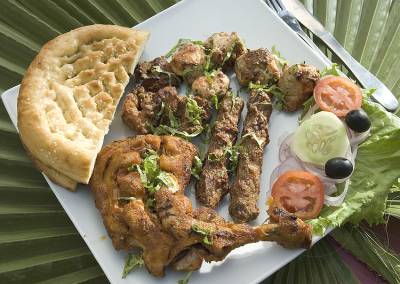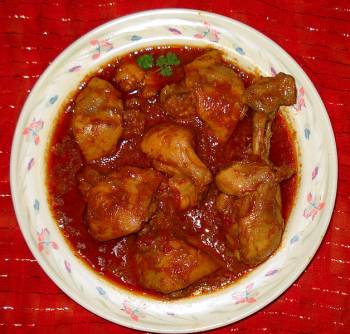Maeve O’Meara explores the delicious world of Pakistani food with some dishes that are loved around the world—like the elaborate biryani—the layered spiced rice and meat dish beloved by Pakistanis. Chef Sonya Kayani makes a marvelous version of biryani using goat curry which she layers with saffron and plain basmati rice to create a feast.
Maeve’s friend Basil Daniell (who ran subcontinent restaurant Oh Calcutta for 19 years) runs through the key ingredients, herbs and spices and shares a very easy lamb dumpling recipe from the wild North-West Frontier region of Pakistan that Basil has adapted by using wonton wrappers.
Maeve explore a very busy Pakistani eatery and discover the big favorites are tandoori chicken and a slow cooked lamb and dhal dish called haleem. Maeve spends a few hours with long time restaurateur Javed Chaudry (Jinnah’s Tandoori and Seafood Restaurant) to see how it's made.
Maeve meets famous Pakistani fast bowler Waqar Younis who shows how Pakistani people love to eat with bread.
Click here for the recipes featured in this episode.
Pakistani Cuisine
 Pakistani cuisine can be described as a refined blend of various regional cooking traditions of the South Asian subcontinent.
Pakistani cuisine can be described as a refined blend of various regional cooking traditions of the South Asian subcontinent.
Since Muslims are forbidden to eat pork or consume alcohol, and the halal dietary guidelines are strictly observed, Pakistanis focus on other areas of food such as beef, lamb, chicken, fish, and vegetables as well as traditional fruit and dairy.
The influence of Central Asian, South Asian and Middle Eastern cuisine in Pakistani food is ubiquitous. As a result, Pakistani cuisine is known for its richness and flavor.
Pakistani dishes are also taking a lead in the western direction, as many Pakistanis are trying out new and modern foods. International cuisine and fast food are popular in cities. Blending local and foreign recipes (fusion food) such as Pakistani Chinese, is common in large urban centres. Furthermore, as a result of lifestyle changes, ready made masalas (mixed and ready to use spices) are becoming increasingly popular.
Within Pakistan, cuisine varies greatly from region to region, reflecting the country's ethnic and cultural diversity. Food from the southern provinces of Sindh and the Punjab is quite similar to the cuisine of Northern India and can be highly seasoned and spicy, which is characteristic of the flavors of the South Asian region. Food in other parts of Pakistan involves the use of mild aromatic spices and less oil, characterizing affinities to the cuisine of neighbouring Afghanistan, Iran, and Central Asia.
In Pakistan, main courses are usually served with wheat bread (either roti or naan), or rice. Salad is generally taken as a side dish with the main course, rather than as an appetizer beforehand. Assorted fresh fruit or sometimes desserts are consumed at the end of a meal.
Spices:
 Pakistani dishes are known for having aromatic and sometimes spicy flavors, and some dishes often contain liberal amounts of oil which contributes to a richer, fuller mouthfeel and flavor. Brown cardamom, green cardamom, cinnamon, cloves, nutmeg, mace, and black pepper are the most commonly used spices in a wide variety of dishes throughout Pakistan. Cumin seeds, chilli powder, turmeric and bay leaves are also very popular. Garam masala (aromatic spices) is a very popular blend of spices used in many Pakistani dishes.
Pakistani dishes are known for having aromatic and sometimes spicy flavors, and some dishes often contain liberal amounts of oil which contributes to a richer, fuller mouthfeel and flavor. Brown cardamom, green cardamom, cinnamon, cloves, nutmeg, mace, and black pepper are the most commonly used spices in a wide variety of dishes throughout Pakistan. Cumin seeds, chilli powder, turmeric and bay leaves are also very popular. Garam masala (aromatic spices) is a very popular blend of spices used in many Pakistani dishes.
Meats:
Meat plays a much more dominant role in Pakistani food, compared to other South Asian cuisines. Of all the meats, the most popular are goat or mutton, and chicken. Korma is a classic dish of Mughlai origin made of either chicken or mutton, typically eaten with rice and is very popular in Pakistan. Beef is also eaten, and is particularly sought after as the meat of choice for kebab dishes or the classic beef shank dish nihari. Seafood is generally not consumed in large amounts, though it is very popular in the coastal areas.
Kebabs are a staple item in Pakistani cuisine today, and one can find countless varieties of kebabs all over the country. Each region has its own varieties of kebabs but some like the Seekh kebab, Chicken Tikka, and Shami kebab are especially popular varieties throughout the country.
Vegetables:
Curries, with or without meat, combined with local vegetables such as bitter gourd, cauliflower, eggplant, okra, cabbage, potatoes, rutabaga, saag, and peppers are most common and cooked for everyday consumption. Pickles made out of mangoes, carrots, lemon etc. are also commonly used to further spice up the food.
Grains:
Various kinds of pulses also make up an important part of the Pakistani dishes. While lentils (called daal), and chick peas (called channa) are popular ingredients in homestyle cooking, they are traditionally considered to be an inexpensive food sources. Because of this reason, they are typically not served to guests who are invited for dinner or during special occasions. Combining meat with lentils and pulses, whether in simple preparations or in elaborate dishes such as haleem, is also a distinctively Pakistani touch not commonly seen in neighboring India where a substantial number of its population are vegetarians.
Basmati is the most popular type of rice consumed in Pakistan. However the average Pakistani householder generally eats plain polished white rice of non-export quality. Dishes made with rice include many varieties of pulao (pilaf). Biryani is a very popular dish in Pakistan and has many varieties. Tahiri, which is also a form of vegetarian biryani, is also popular.
Pakistanis also eat flat round bread (roti) as a staple part of their daily diet. Pakistan has a variety of breads, often prepared in a traditional clay oven called a tandoor. Some of these are: chapatis, tandoori roti, paratha, naan, kulcha, taftan, and puri. All of the main dishes (except those made with rice) are eaten alongside bread. To eat, a small fragment of bread is torn off with the right hand and used to scoop and hold small portions of the main dish.
Desserts:
Popular desserts include Peshawari ice cream, sheer khurma, kulfi, falooda, kheer, rasmalai, phirni, zarda, shahi tokray and rabri. Sweetmeats are consumed on various festive occasions in Pakistan. Some of the most popular are gulab jamun, barfi, baklawa, kalakand, jalebi, and panjiri.
Beverages:
Pakistanis drink a great deal of tea (locally called, chai). Both black and green tea (sabz chai / qehwa) are popular.
Besides tea, there are other drinks that may be included as part of the Pakistani cuisine. All of them are non-alcoholic as the consumption of alcohol is prohibited by Islam. drinks such as coffee and soft drinks have also become popular in Pakistan. It is very common to have soft drinks now days with Pakistani meals. Other popular drinks are lassi, gola ganda, sugarcane juice (Ganaay ka ras), and lemonade (limu pani), Rooh Afza.
Episodes:
 |
AFRICAN: Wherever you are in Africa, no meal is complete without a starchy porridge known as fufu. |
 |
BRAZILIAN: An exuberant, colorful mix of Portuguese, African and native foods including some from the Amazon. |
 |
CHINESE: Two thirds of households own a wok and use it regularly, but not everyone knows how to use it properly. |
 |
EGYPTIAN: Beans are used extensively and creatively as a source of protein, fibre, and comfort. |
 |
ENGLISH: "Meat & three veg" originated in the UK with dishes like roast beef, steak and kidney pie, and many more. |
 |
FRENCH: The French have elevated food into an art form. Nowhere else is so much attention paid to what people are going to eat and how. |
 |
HUNGARIAN: A fusion of simple peasant food & the elegant, highly developed cuisine from the days of the Austro Hungarian Empire. |
 |
INDIAN: A vibrant, intensely colorful cuisine. Each region of India has its own style of cooking and distinct flavors. |
 |
INDONESIAN: One of the most vibrant and colorful cuisines in the world, full of intense flavor and varied textures. |
 |
ITALIAN: An long-awaited introduction to the kitchens and restaurants of Australia’s top Italian chefs and home cooks. |
 |
JAPANESE: Refined and elegant, its preparation and presentation honed over the centuries so its flavors are pure and delicate. |
 |
JEWISH: While flavors of the Jewish palate are influenced by geography, the constant for Jews all over the world are the Kosher laws. |
 |
KOREAN: Some of the healthiest food on earth, with a near obsession with the fermented vegetable kimchi. |
 |
LEBANESE: Lebanese cuisine is generous and abundant, and this is some of the most exquisite food in the world. |
 |
MALTESE: The rocky island of Malta is home to some beautiful rustic recipes that sing of Mediterranean flavor and freshness. |
 |
MEXICAN: Authentic Mexican food is vibrant, spicy, delicious and fun. It varies according to which region its from. |
 |
MOROCCAN: One of the most cleverly balanced cuisines on earth; spices are used to enhance the flavor of dishes. |
 |
PERSIAN: From simple dips to hearty stews, food preparation is taken very seriously in Iran and is often a labor of love. |
 |
SOUTH AMERICAN: A fantastic fusion of culinary traditions from indigenous Indians, imported Africans, and the Spanish and Portuguese colonist. |
 |
SRI LANKAN: This beautiful spice island is a rich melting pot of every nationality that has visited and traded with it over the years. |
 |
SYRIAN: One of the highlights of Syrian food is mezza, a generous spread of small dishes and the prelude to even more food! |
 |
TURKISH: Nestled between Asia and Europe, Turkish food is an unique and exotic fusion with influences from many countries. |
Contact Us | Shop | Sitemap | Join Our Team | Investors | Advertise | Web Design Services
Community | Foodies' Choice | Meetup Groups | Chat | Blogs | Forums | Submit Your Site | Resources

